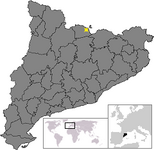Puigcerdà
| Puigcerdà municipality | ||
|---|---|---|
| coat of arms | Map of Spain | |

|
|
|
| Basic data | ||
| Autonomous Community : |
|
|
| Province : | Girona | |
| Comarca : | Cerdanya | |
| Coordinates | 42 ° 26 ' N , 1 ° 56' E | |
| Height : | 1202 msnm | |
| Area : | 18.92 km² | |
| Residents : | 9,258 (Jan 1, 2019) | |
| Population density : | 489.32 inhabitants / km² | |
| Municipality number ( INE ): | 17141 | |
| administration | ||
| Official language : | Castilian , Catalan | |
| Mayor : | Albert Piñeira Brosel | |
| Website : | www.puigcerda.com | |
| Location of the municipality | ||

|
||
Puigcerdà [ ˌputʃsərˈða ] is a small town and a winter sports resort in Catalonia ( Spain ) in the province of Girona . The city has 9258 inhabitants (as of January 1, 2019) and is the administrative center of the Comarca Cerdanya .
Geographical location
Puigcerdà is located at an altitude of 1202 m in the Catalan Pyrenees in the wide valley of the Segre River, right on the border with France .
Community structure
- Puigcerdà
- La Guingueta
- Rigolisa
- Sant Marc
- Sant Martí (Puigcerdà)
- Deuloféu
- Ventajola
- Age (Puigcerdà)
- Vilallobent
history
King Alfonso I founded the village between 1170 and 1177 and granted it the status of a capital (the county of Cerdanya ). Until 1345 the city was one of the seven most important places in Catalonia. After the earthquake of 1428 a new castle was built. In the Pyrenees Treaty of 1659 , the eastern part of the Cerdanya, the Alta Cerdanya , fell to France , and Puigcerdà became a border town. In 1886 the city walls were razed. In 1922 the city was connected to the railway network. Puigcerdà developed into a summer resort. After the Spanish Civil War , winter sports gradually took hold and since 1956 ice hockey has even been played there.
Attractions
Earthquakes, fires and border conflicts are responsible for the fact that little of the historical building fabric has been preserved. So in the middle of the village you can only find a Gothic bell tower of the no longer existing Church of Santa Maria. However, there is a lively atmosphere in the narrow streets of the city center, which makes a visit worthwhile. The Schierbeck Park, which was laid out around the small lake north of the old town at the end of the 19th century, should also be emphasized.
traffic
The place has had a train station on the Barcelona – Latour-de-Carol - Enveitg line since 1922 . In 1928, the Spanish broad gauge line was extended across the state border to Latour-de-Carol - Enveitg station. A year later, a French standard gauge track reached the Puigcerdà station from there , which as a border station received extensive facilities for passenger and goods handling . In the 1990s this track was interrupted, the goods facilities are orphaned. There are no more trains coming from the French side, four of the seven daily passenger trains from Barcelona continue to Latour-de-Carol (as of 2015).
Sons and daughters
- Pere Borrell del Caso (1835-1910), painter
- Gemma Arró Ribot (* 1980), ski mountaineer
- Daniel Almendros (* 1982), ice hockey player
- Aleix Pubill Rodríguez (* 1988), ski mountaineer
Web links
Individual evidence
- ↑ Cifras oficiales de población resultantes de la revisión del Padrón municipal a 1 de enero . Population statistics from the Instituto Nacional de Estadística (population update).

